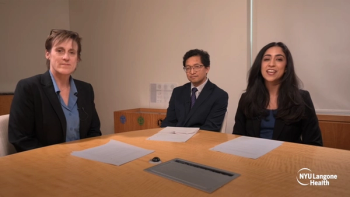
Clinical Implications of Port Delivery System in Retinal Diseases
Closing out his discussion on the port delivery system in retinal diseases, Chirag Jhaveri, MD, considers how this approach has impacted the treatment landscape.
Transcript:
Chirag Jhaveri, MD: I think the port delivery system [PDS] can have a very significant clinical impact on the treatment of wet AMD [age-related macular degeneration]. We’re all aware of the treatment burden patients have with frequent intravitreal injections. In addition, we know the peaks and troughs of anti-VEGF injections can affect the recurrence of wet AMD. Given that it is a continuous delivery of anti-VEGF therapy, not only can this potentially reduce the treatment burden for patients, there is also a possibility for disease modification with the port delivery system.
The fact that many patients in the LADDER study did not even meet refill criteria, and that 98% of patients in the ARCHWAY trial did not need any additional treatment before the first refill, implies that we may be actually modifying the disease to the point of even potential quiescence for some of these patients.
Now that we have the port delivery system as an approved option, it’s important to consider how it can fit into our treatment plan. I have plenty of patients who require monthly or Q2 monthly [every 2 months] intravitreal injections. I think these are the patients I will first have a discussion with, and talk to them if they’re interested in potentially having a longer-term delivery of intravitreal anti-VEGF. Reducing the treatment burden will be very appealing for many of these patients. Of course, the risk and benefits of surgery need to be weighed carefully for such patients. One of the factors that I consider for PDS is the frequency of injections that the patients have. I also will look at the stability for these patients. If these patients can be stable on a monthly or every 2 months setting, we may still discuss it. However, if they’re having recurrent fluid, I think I’ll be much more likely to discuss the port delivery system. If a patient happens to be very stable with injections only every 3 or 4 months, the port delivery system may not be as appealing for some of these patients, unless they’re against getting transscleral intravitreal injections. With respect to insurance approval, of course many of these questions are yet be answered. However, we certainly hope and anticipate for insurance to cover this procedure. It is yet to be determined if it will be a step-wise approach, but I surely hope these critical patient-care decisions are left up to the physician, with explanation and discussion with the patient, and not mandated policy.
Having performed many of these surgeries already during the clinical trials, I can say that the patients who have received the port delivery system are quite happy. They do notice a stability of their disease. In addition, with the refill procedure, although technically it is very different from an intravitreal injection, and the surgeon has to be very aware of the different techniques, for the patient experience, it’s quite nice. It’s more tolerable because there’s no transscleral penetration of a needle. Patients often report that this was a much more comfortable and easier process to do. In terms of the implantation, it’s also considered to be quite painless. Most patients may have a little bit of itchiness or mild irritation immediately in the first 1 to 2 days of the postoperative period. Otherwise, it is a very well-tolerated procedure, and patients seem to have a very good experience.
With the approval of the port delivery system for neovascular AMD, I think the future for this platform is quite interesting; it has a lot of great potential. Studies are underway for both diabetic macular edema, as well as diabetic retinopathy. In addition, as we develop better compounds that may be more efficacious, such as bispecific molecules, marrying the PDS platform with these new molecules may yield even better results for our patients. I think there are a lot of exciting possibilities for the PDS platform.
As our retina specialty embarks upon a new era for the treatment of wet macular degeneration, I think as colleagues, it’s important that we utilize all the resources available. I highly encourage you to use all of the information, as well as surgical device liaisons, for example, in order to help maximize our patient outcomes.
Transcript edited for clarity.
Newsletter
Don’t miss out—get Ophthalmology Times updates on the latest clinical advancements and expert interviews, straight to your inbox.














































